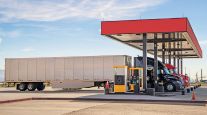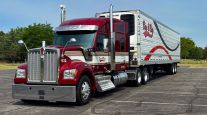Data: Separating the Wheat From the Chaff
This story appears in the Jan. 11 print edition of iTECH, a supplement to Transport Topics.
The old adage “separating the wheat from the chaff” technically describes the process of separating grain from the casing in which it’s grown, but over the years, the saying has broadened to describe any process that isolates what’s valuable by winnowing out what’s worthless. For fleets trying to wring value from the massive volume of data they produce each day, separating the wheat from the chaff can be achieved through careful development of analytics programs, which zero in on factors that shape a company’s results by setting aside those that do not.
BEST OF JANUARY iTECH: More stories, columns
“The most relevant information is not always the most obvious,” said Dean Croke, a vice president with Omnitracs Analytics, during the annual joint conference of the Information Technology & Logistics Council and National Accounting & Finance Council of American Trucking Associations. The conference was held during October in conjunction with ATA’s Management Conference & Exhibition in Philadelphia.
Croke said that relevant information is identified through a process called reductive modeling, which filters out irrelevant data and isolates the most prevalent and frequently occurring information.
“The system studies all of [the information] and kicks out the things that do not appear throughout,” Croke said. “It takes three months to get a model; it takes a lot of iterations to narrow it down. You have to start with everything to figure out which things are relevant. A model tells you what matters.”
And filtering through the mountains of data being collected is not a problem — the technological capability is there for fleets to fine-tune analytics to suit their needs, he said.
“We have increasing ability to process the data,” he said. “We can do it in a manner of seconds; the costs of sending data and the cost of storing data all have come down. The key to effective data analytics is selecting the metrics around which to build [an analytics] model.”
It’s also important to understand the operational factors contained within the data, especially as they relate to the trucks themselves, said Thomas Fansler, president of Vusion, a division of PeopleNet focused on analytics.
“Context matters,” he said, including environmental factors such as temperature, topography and whether a vehicle is being used in an urban, local or over-the road environment. All of these factors come together, Fansler said, when information from various sources is combined and decoded.
“How is that asset being used? How much time was it empty or loaded? How many stops did that vehicle have? How much speed, [and] how much braking?” he asked. “We bring that data together. We are bringing in GPS, [electronic control module] data, fuel data and [transportation management system] data which gives us access to load weight information.” That, in addition to vehicle-specific factors that can include aftermarket equipment, presents fleets with “an overwhelming amount of information,” Fansler said. “How do you distill that information down into what is important in order to make better decisions?”
For one, he said, it’s important to use baseline information, such as data from the original equipment manufacturer.
“For every asset, there is a predicted value and an actual value,” he said, noting that when data are correlated and models are applied, analytics can present “the relationship between what the OEM reported as fuel economy and what the physical fuel economy of that truck actually is. Some of those vehicles have a bias for over-reporting fuel economy or underreporting gallons consumed. We want to account for that when we are recreating and estimating performance.”
Fansler added, “We can build models that help us understand and decode environment, decode driver behavior, decode weight. How much are weight and changes in weight going to impact fuel economy on that vehicle?”
Fansler noted that it is here where predictive models can tell a more complete story.
“A traditional miles-per-gallon report lacks context,” he said. “When I am a fuel or maintenance manager, and I have vehicles on an MPG report, the first thing I am going to say is, ‘I’ve got some high-performing vehicles and some low-performing vehicles. What is the underlying cause of that difference? How much weight was in the trailer, and what were those vehicles hauling? What lanes were they traveling, and what was the topography?’ All of these factors influence asset performance.”
The sharing of this type of information between vehicles, or between vehicles and surrounding infrastructure, may soon drive the next leap in data collection under the connected-vehicle program now being developed by the National Highway Traffic Safety Administration. The program is intended to improve highway safety through transmission of so-called “basic safety messages,” which are sent 10 times per second between vehicles and nearby structures, said Robert Kreeb, chief of NHTSA’s Intelligent Technologies division. Messages such as distance to the next exit, for example, are part of the system, he said.
The program is currently focused on passenger vehicles, but heavy trucks are also being studied, Kreeb said. And while the program is still in the developmental stages, so far one challenge has arisen with how tractor-trailers may function within the program’s framework.
“Tractor-trailers are articulated vehicles,” Kreeb said. “We have not figured out how to handle articulated vehicles.”
The reason, he said, is that the BSMs list location, length and width of shapes on the road, and the system currently recognizes the tractor and trailer as individual items, not one. But, he said, the agency does not see this as a major challenge and expects that heavy trucks eventually will become more incorporated into the program.
Joe Howard, information manager for ITLC, is a former editor at Transport Topics. He can be reached at jhoward@trucking.org.




